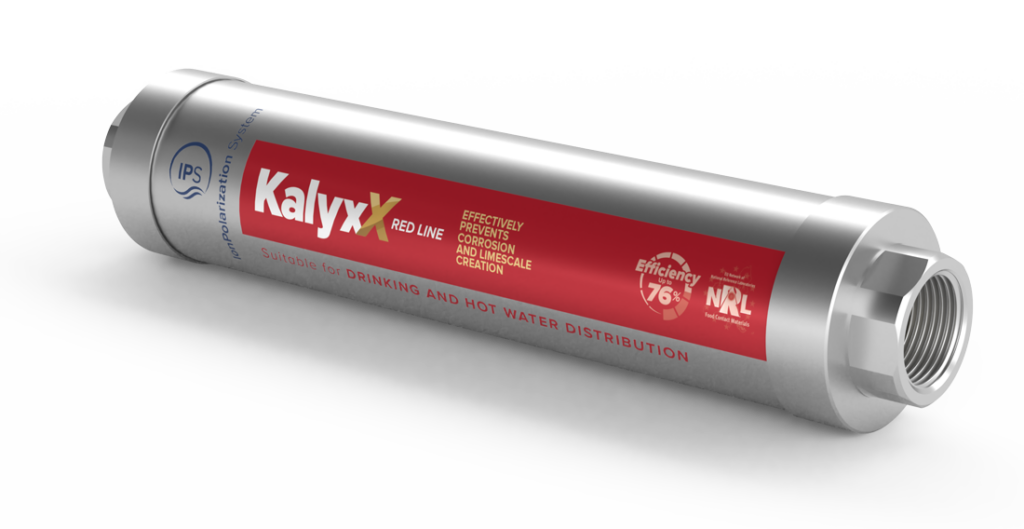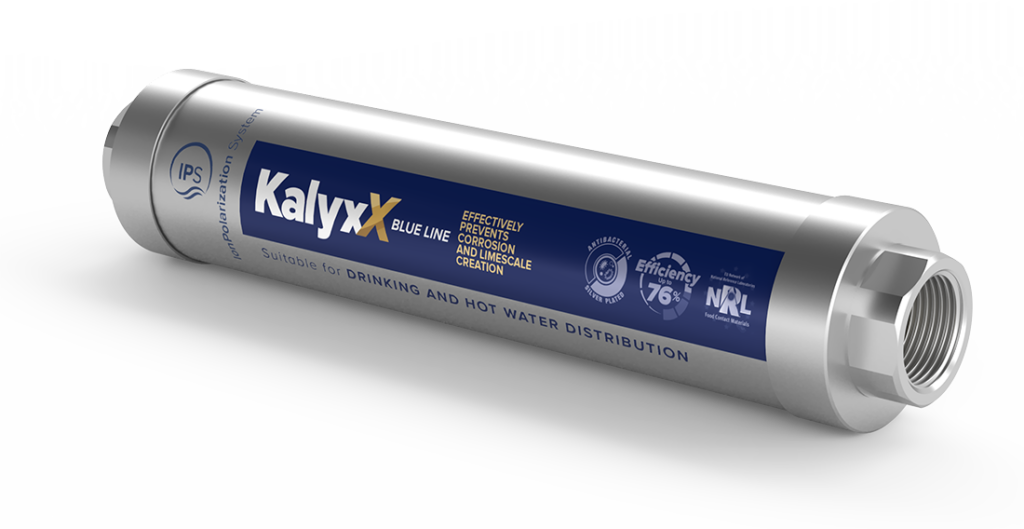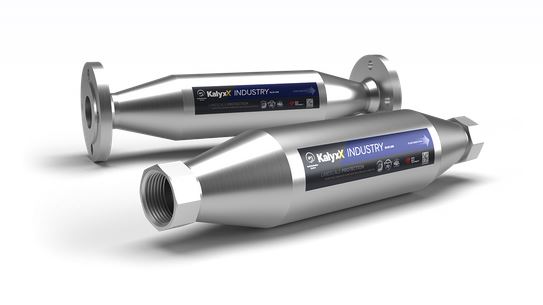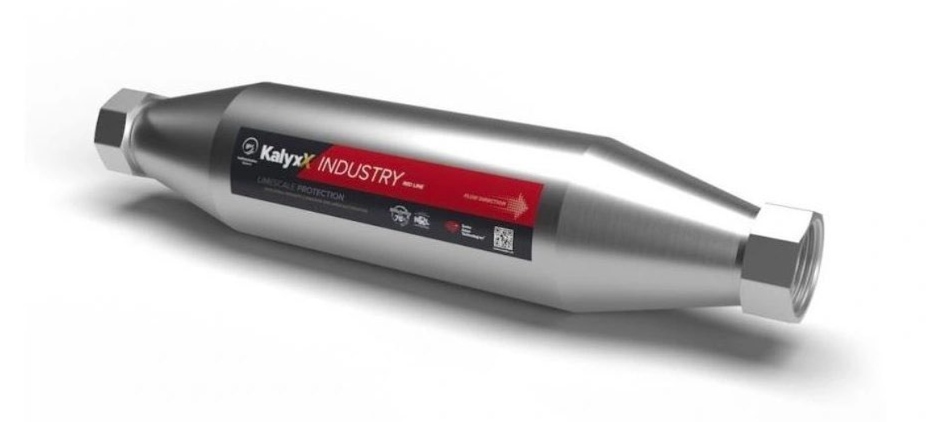Jsme na trhu přes 15 let a máme bohaté zkušenosti s malými i velkými projekty. Naši klienti jsou velké nadnárodní společnosti, firmy a jednotlivci.
Ion Polarization System (IPS)
- Účinná prevence a redukce existujícího vodního kamene
- S anti-korozivním efektem
Klíčové otázky a odpovědi
Účinnost zařízení IPS KalyxX je závislá na dvou hlavních faktorech a to je elektrické pole, které se vytváří rozdílným materiálem elektrod a intenzita reverzní turbulence v důsledku jejich tvaru. Čím je průtok zařízením vyšší, tím je turbulence intenzivnější.
V laboratoři jsme zkoumali vliv nízkého průtoku na účinnost zařízení, přičemž jsme dospěli k závěru, že k úplné ztrátě účinnosti IPS KalyxX vlivem nízkého průtoku nedojde, dojde pouze k jejímu poklesu.
Při průtoku 5 l/min (malý průtok) jsme zaznamenali účinnost přibližně 50%, což je stále vysoká účinnost ve srovnání s konkurenčními výrobky. Při zvyšování průtoku se samozřejmě účinnost zvyšuje. Horní hranice hodnoty průtoku je definována maximálním průtokem pro daný model a nedoporučuje se překračovat tuto hodnotu. Neznamená to však, že by zařízení nebylo účinné i při vyšších hodnotách průtoku.
Níže uvedené informace jsou převzaty přímo od výrobce produktů IPS – Swiss Aqua Technologies.
FAQ
Níže uvedené informace jsou převzaty přímo od výrobce produktů IPS – Swiss Aqua Technologies.
Jak ovlivňuje teplota účinnost?
Z provedených testů vyplývá, že IPS vykazují mírné zvýšení účinnosti v TUV, což je podloženo i mírným zvýšením napětí mezi elektrodami. Toto tvrzení podporují i reference z nasazení IPS KalyxX do recirkulačních obvodů.
Co však nedoporučujeme je instalace IPS do zařízení, kde dochází k produkci páry – vzhledem k extrémnímu teplotnímu spádu nelze zařízením dosáhnout požadovanou účinnost.
Jak dlouho anoda v IPS vydrží v těžkých elektrolytech?
Při běžném použití IPS KalyxX, kde elektrolyt tvoří pitná voda, jsou obě elektrody poměrně stálé a jejich životnost je až 10 let. V případě vody s rostoucí kyselostí (nízkým pH) se životnost snižuje (až na 4 roky).
V laboratoři jsme testovali vliv roztoků s vysokým pH na čas rozpuštění zinkové elektrody. Testovali jsme roztok s pH 3 a 1,4, přičemž jsme elektrody v tomto roztoku nechali ponořené 1 týden. V roztoku s pH 3 byly viditelně barevné změny, úbytky na hmotnosti byly zanedbatelné. Roztok s pH 1,4 způsobil rozpad zinkové elektrody.
Je napětí napříč zařízením měřitelné?
Napětí není standardně uživatelsky měřitelné. Pro laboratorní měření je třeba provést malé úpravy, aby bylo možné k „vital“ turbínám připojit měřicí zařízení a sledovat hodnotu napětí mezi mini.
Hodnota napětí však není až tak výrazně závislá na parametrech průtoku. Měřeními jsme zjistili, že hodnota napětí je přibližně konstantní (variuje kolem střední hodnoty) a se zvyšujícím se průtokem se zvyšuje pouze mírně (řádově desetiny voltu). Také jsme zjistili, že mírný nárůst napětí jsme schopni dosáhnout vyšší teplotou vody, která protéká zařízením (rychlejší pohyb elektronů v elektrolytu s vyšší teplotou).
Největší vliv na napětí mezi „vital“ turbínami má samotné mineralogické složení vody, kde platí, čím je voda bohatší na minerály, tím můžeme dosáhnout vyšší napětí. Limity napětí mezi turbínami jsou ohraničené galvanickým potenciálem materiálu, ze kterého jsou „vital“ turbíny vyrobeny. V zařízeních IPS se snažíme vytvořit podmínky, které zaručí jeho maximální hodnotu a využití.
Ovlivňuje vysoký obsah železa ve vodě účinnost? Jaký je průběh?
Z důvodu, že naše testování provádíme na vodě, která není žádným způsobem upravována, není možné provádět exaktní srovnávací testy při různých obsazích železa ve vodě. Z fyzikálního hlediska nevidíme důvod proč by měl mít obsah železa ve vodě negativní vliv na jeho účinnost.
Naše tvrzení podporují i zkušenosti z praxe, kde byly naše zřízení nasazeny do systémů, kde měla voda vysoký obsah železa – na účinnost tento faktor vliv neměl. Po rozebrání a kontrole byl na elektrodách přítomen jemný železitý nános, který byl snadno omyvatelný – bez ovlivnění účinnosti. Samozřejmě voda s různým složením a obsahem jednotlivých složek může jistým způsobem ovlivnit účinnost, ať už pozitivně nebo negativně.
Je nezbytné instalovat IPS společně s filtrem na mechanické nečistoty?
Obecně lze uvést, že v instalačních rozvodech jsou obsaženy zařízení s vyšší citlivostí na mechanické nečistoty (na jejich menší velikost) než IPS. Potřeba ochrany IPS filtrem na mechanické nečistoty je potřeba až v případě nečistot ve vodě 50 μm a větších.
Jak podstatné jsou tlakové ztráty?
Konstrukce, materiálové složení i vnitřní skladba elektrod v IPS je volena s ohledem na maximální účinnost. Tlakové ztráty průtokem zařízením jsou však zanedbatelné, řádově v setinách až desetinách procenta.
Antibakteriální efekt IPS KalyxX BlueLine
Od starověku je známo, že ionty stříbra jsou účinné proti širokému spektru mikroorganismů. Dnes se stříbro používá k regulaci bakteriálního růstu v různých odvětvích od lékařských aplikaci až po produkty běžné spotřeby jako jsou pračky, myčky nádobí, chladničky či dokonce sedadla toalet. Stejný princip je využíván i v zařízeních IPS KalyxX BlueLine, které nejen mění krystalickou strukturu vodního kamene CaCO3 z formy kalcitu na aragonit, čímž chrání zařízení před vytvářením nežádoucích nánosů, ale díky obsaženému stříbru poskytuje i antibakteriální efekt.
Pro správné pochopení principu fungování antibakteriálního efektu zařízení IPS KalyxX je třeba pochopit mechanismus antibakteriálního účinku samotného stříbra. Stříbro a většina jeho sloučenin má oligodynamický účinek, který je pro bakterie, řasy a houby toxický. Oligodynamický efekt označuje antiseptický účinek stříbra na určité patogeny. Tento jev nastává již při velmi nízké koncentraci stříbra, a je založen na specifické absorpci iontů stříbra na povrchu bakterií. To znamená, že účinnost stříbra jako antiseptika je založena na schopnosti aktivního iontu stříbra inverzně poškodit klíčové enzymové systémy v buněčných membránách patogenů. Zajímavou vlastností iontů stříbra je takzvaný „zombie efekt“, kdy mrtvé bakterie, které již obsahují stříbro mohou být zdrojem stříbra, a tak mohou zabíjet další bakterie. Antibakteriální účinek se výrazně zvyšuje v přítomnosti elektrického pole.
Obecně jsou dosud známy tři vědecky prozkoumané mechanismy, pomocí nichž stříbro působí na mikroorganismy:
- Ionty stříbra dokážou vytvářet póry a propíchnout bakteriální buněčnou stěnu tím že reagují s peptidoglykanové složkou;
- Ionty stříbra inhibují dýchání buněk a narušují metabolické dráhy, což vede k tvorbě ROS – reaktivních kyslíkových druhů;
- Stříbro v buňkách bakterií narušuje DNA a jejich replikační cyklus;
Stříbro zvyšuje aktivitu enzymů, které se podílejí na dělení buněk, a tak významně zpomaluje jejich množení. Díky tomu má antibakteriální nebo bakteriostatické účinky.
IPS KalyxX BlueLine zajišťuje svůj antibakteriální efekt využíváním uvedených mechanismů prostřednictvím stříbrných elektrod a přítomnosti elektrického pole mezi mini, které celý efekt umocňuje. Laboratorními testy byla zjištěna při dané skladbě zařízení IPS KalyxX BuleLine 40% redukce bakterií E. Coli. Avšak nejedná se o hlavní funkci tohoto zařízení, hlavní funkcí nadále je rekrystalizace struktury vodního kamene a antibakteriální efekt rozšířenou velmi pozitivní vlastností.
A co možné zabarvení vody po použití IPS?
Voda s vysokým obsahem minerálů je označovaná jako tvrdá. Tento vysoký obsah minerálů je pozitivní pro lidské zdraví uživatele, negativním dopadem jejího používání je však usazování těchto minerálů v průběhu užívání na stěnách rozvodů a zařízení v podobě tvrdého nánosu známého jako vodní kámen (rozdíl působení vodního kamene na ohřívač vody s ochranou IPS a bez ní viz obrázky 1 a 2 – zdroj Applied Technical Service,s USA).
Používáním zařízení IPS není narušena chemická rovnováha vody, pouze dochází k re-krystalizaci obsažených minerálů fyzikální cestou, především vápníku a hořčíku, které jsou stavebním prvkem pro vznik vodního kamene.
Tato změna podoby krystalické mřížky minerálu způsobí, že již není schopen vytvářet tvrdé inkrusty na površích, ale je formou jemného prášku odplavován proudící vodou (viz obrázek 3 – zdroj Swiss Aqua Technologies, Swiss). Jedná se o mikroskopické změny a takový efekt není zpravidla lidským okem rozpoznatelný. Je-li však voda extrémně tvrdá, může se někdy stát, že po napuštění se zdá být s mírným bílým efektem.
Tento jev není v žádném případě negativní pro uživatele. Naopak. Obsah, pro lidské zdraví důležitých minerálů, je ve vodě zachován a neusazuje se na stěnách zařízení. Je tak mimo jiné potvrzena i efektivita zařízení IPS.
Ve většině případů efekt takzvané „bílé vody“ způsobuje vzduch rozpuštěný ve vodě – miliony miniaturních vzduchových bublinek (viz. obrázek 4 – zdroj Swiss Aqua Technologies, Swiss). K tomuto jevu dochází běžně při kontaktu studené vody z distribuční sítě s rozvody vody, které mají vyšší teplotu. Tento jev způsobuje také perlátor umístěn na výstupu vodovodní baterie nebo jej můžeme pozorovat po různých opravách prováděných na vodovodním potrubí, kde se do rozvodné sítě dostane vzduch. „Bílou vodu“ může rovněž způsobovat i efekt TGP, který využívají zařízení IPS, protože v jejich průtokové komoře dochází k turbulentnímu proudění, které stejně uvolní vzduch z vody a rozptýlí ho na velmi malé bublinky. Takové zakalení vody není absolutně nebezpečné a nemá žádný negativní vliv na chuť, kvalitu a zdraví spotřebitele. Vzduch v takto zakalené vodě postupně vyprchá, což znamená že pokud se taková voda nechá několik minut odstát aby se uvolnily všechny bublinky, zákal se ztratí a voda bude opět průzračná.
Sekundárním efektem IPS může být, že voda takto upravená působí na odplavování již dříve vytvořeného vodního kamene. Opět se jedná o velmi pozvolný jev, který často není rozpoznatelný lidským okem. Je-li však historická vrstva vodního kamene významně veliká, zpočátku se napouštěná voda může zdát být mírně zakalena (extrémní případ viz obrázek 5 – zdroj Siam Cast Nylon, Thailand). Opět to neznamená v žádném případě negativní dopad na lidské zdraví, jedná se opět o minerály, které jsou pro lidské zdraví naopak potřebné. A opět to jen potvrzuje efektivitu použití IPS, v tomto případě také z hlediska postupného odstranění již vzniklého vodního kamene. Uživatelský komfort však může být menší. To je však způsobeno samotným vodním kamenem, který v rozvodech byl i před instalací IPS, ale jeho přítomnost si uživatel třeba neuvědomoval.
Varianty produktů
IPS KalyxX RedLine/BlueLine
Snižuje tvorbu vodního kamene na vodovodních prvcích (potrubí, ventily, kohoutky, sprchové hlavice, ohřívače vody pro domácnost) s účinností 76%.
Vhodný pro studenou (pitnou) vodu a teplou vodu. Má certifikát NRL pro přímý stálý kontakt s pitnou vodou, dokonce každá část IPS je vyrobena z materiálu vhodného pro kontakt s pitnou vodou.
Varianta Blueline navíc obsahuje postříbřené komponenty pro zabránění růstu bakterií.




IPS KalyxX Industry RedLine/BlueLine
Použití IPS Industry je efektivní a vhodné v jakémkoliv provozu na tekoucí vodu – umývací linky, restaurace, jídelny, pekárny, prádelny, kadeřnictví, čistírny, bazény, mlékárny, pivovary, lihovary, zahradnictví, zavlažovací systémy a další. Funguje také spolehlivě ve výměnících tepla, vodních systémech, bojlerech, kondenzátorech, generátorech, topných systémech, kompresorových místnostech, chladicích a klimatizačních zařízeních.
- Řešení pro bytové domy a budovy s vyšším hodinovým průtokem.
- Vhodný pro přímý okruh tepelného čerpadla voda – voda s vysokým výkonem, pro stabilizaci čističe odpadní vody na hodnotách garantovaných výrobcem.
- Instalace u vstupu do budovy.
- Potrubí na přívod studené vody pro ústřední topení na předávacích stanicích a kotelnách.
- Zabraňuje usazování vodního kamene u deskových výměníků tepla.
- Stabilizace bodové koroze akumulačních ohřívačů.
Proč do toho jít s námi?
Je na nás spolehnutí
- Vyřídíme za vás vše, od papírů až po realizaci
- Díky bohatému seznamu dodavatelů vám najdeme to nejlepší řešení
Máte u nás kompletní servis
- Napište nám, jaké řešení by vás přesně zajímalo a jak vypadá budova.
- Spojíme se a zeptáme se vás na další důležité detaily.
- Získáme od dodavatelů návrhy a cenové nabídky.
- Doporučíme vám tu, která je v hodná přesně pro vaši lokalitu.
- Pohlídáme realizaci přímo na místě, aby vše proběhlo podle plánu.
- I po skončení zůstaneme v kontaktu.



